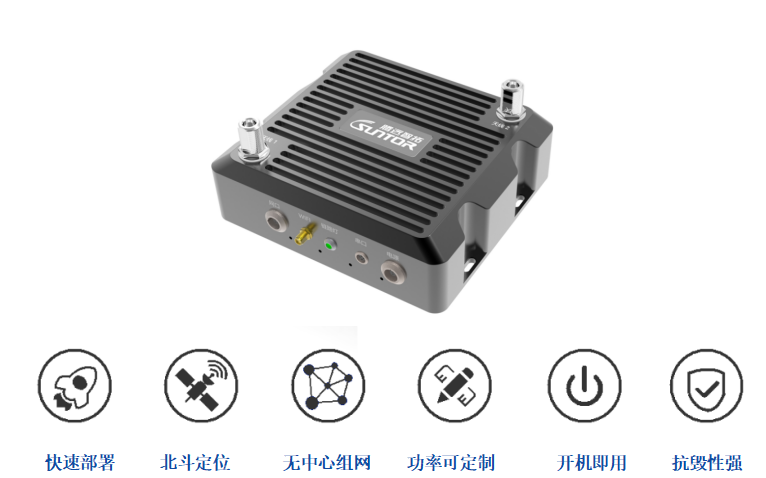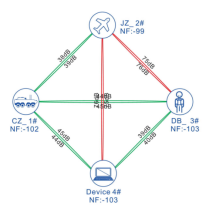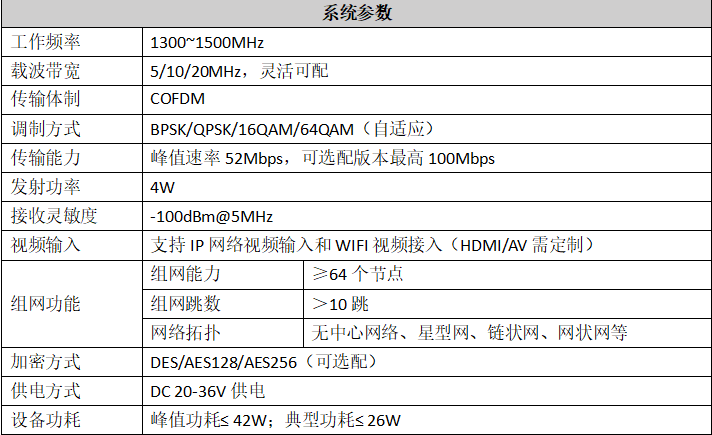Unmanned aerial vehicles (UAVs) are specialized aircraft that do not require onboard personnel for direct operation. Instead, they are controlled via ground control stations or remote control devices, or they execute pre-defined flight tasks through autonomous flight control systems.
Unmanned boats are fully automated surface robots that can navigate on water according to preset tasks without remote control, relying on precise satellite positioning and their own sensors.

Introduction to self-organizing network technology:
The self-organizing network radio for unmanned systems is compact, lightweight, and easy to install, making it particularly suitable for applications requiring lightweight networking, such as UAVs, unmanned vehicles, unmanned boats, and robots. It supports rapid networking and automatic multi-hop relaying, allowing for quick establishment of interconnected networks with handheld systems, vehicle-mounted systems, and surrounding base station networking equipment to achieve efficient collaboration. It features: BeiDou positioning functionality, WiFi coverage support, and can work with smart terminals with WiFi capabilities for various communications. The system employs co-frequency networking and multi-hop relaying, supporting any network topology such as point-to-point, point-to-multipoint, chain relay, mesh networks, and hybrid topologies. It provides wireless broadband communication for emergency response, anti-terrorism, covert reconnaissance, special operations, disaster relief, and routine patrols, ensuring timely communication. Transmission distances can exceed 10 km in open ground environments, and range from 300 to 1000 m in obstructed environments (depending on the obstruction), with air-to-ground distances exceeding 30 km.
Main Features:
-
No central networking: Nodes are equal in status and can act as terminal nodes, relay nodes, or central nodes.
-
Any structure networking: Nodes automatically identify and select the optimal bandwidth data routes.
-
Security and confidentiality: Layered encryption through working frequency points, carrier bandwidth, and scrambling codes, supporting DES encryption.
-
Anti-interference and anti-destruction: Utilizing COFDM, MIMO, ARQ, and other technologies to enhance data bandwidth and interference resistance.
-
Flexible multi-node networking: Automatically calculates link routes based on channel quality, rate, and error rates for flexible networking.
-
Full IP networking interoperability: Supports data transparent transmission and interconnectivity between various systems, enabling real-time multimedia service interactions.

Self-organizing network technology combines the characteristics of UAVs, unmanned boats, and cluster networking to achieve efficient, flexible, and secure communication. Below is a detailed explanation of this technology:
1. High-performance self-organizing network capabilities:
The air-sea self-organizing network radio must have strong self-organizing network capabilities, supporting multi-hop networking. This decentralized network structure allows for communication between nodes, whether UAVs or unmanned boats, to communicate freely within the network without relying on fixed infrastructure.
To meet the special requirements of air-sea environments, the radio must support high-speed mobility and dynamic topology changes. This means that when nodes (such as UAVs and unmanned boats) move or join/leave the network, the radio can automatically adjust the network structure to maintain continuity and stability of communication.
2. Transmission power and protection level:
To ensure effective communication for UAVs and unmanned boats over long distances or in harsh environments, the air-sea self-organizing network radio must have high linear transmission power. For example, a transmission power of up to 10W can ensure clear communication over longer distances.
Additionally, the radio must have a high protection level, such as IP67, which can withstand harsh environments (such as salt fog, humidity, high temperatures, etc.) to ensure the radio operates normally in various conditions.
3. Support for multiple communications:
The air-sea self-organizing network radio should support not only traditional voice communication but also data and image transmission. This allows UAVs and unmanned boats to transmit real-time video, images, and other critical data, providing comprehensive battlefield information to command centers.
Moreover, the radio should support 4G/5G LTE public network access and 2.4G WiFi, enabling UAVs and unmanned boats to interconnect with other devices or networks for broader communication ranges and functionalities.
4. Cluster management capabilities:
The air-sea self-organizing network radio must have cluster management capabilities, allowing for unified management and control of multiple UAVs and unmanned boats. This helps enhance the collaborative operational capabilities and efficiency of UAV and unmanned boat clusters.
Through cluster management capabilities, the command center can monitor the location, status, and communication conditions of each node in real-time for unified scheduling and command.
5. Security and reliability:
In cluster networking, security and reliability are critical. The air-sea self-organizing network radio must employ advanced security technologies, such as encrypted communication and identity authentication, to ensure the security and confidentiality of communication content.
Additionally, the radio must possess high reliability, able to operate stably for extended periods in harsh environments. Redundant designs and fault self-recovery technologies can ensure that the radio quickly recovers normal operation in the event of a failure.

Recommended Parameters:

In summary, the air-sea self-organizing network radio technology integrates the characteristics of UAVs, unmanned boats, and cluster networking, achieving efficient, flexible, and secure communication through high-performance self-organizing network capabilities, high linear transmission power, multi-communication support, cluster management functions, and innovations in security and reliability. This is of great significance for enhancing the collaborative operational capabilities and efficiency of UAV and unmanned boat clusters.
If you find this useful, follow, like, and share it!
Other contact WeChat: dh2541